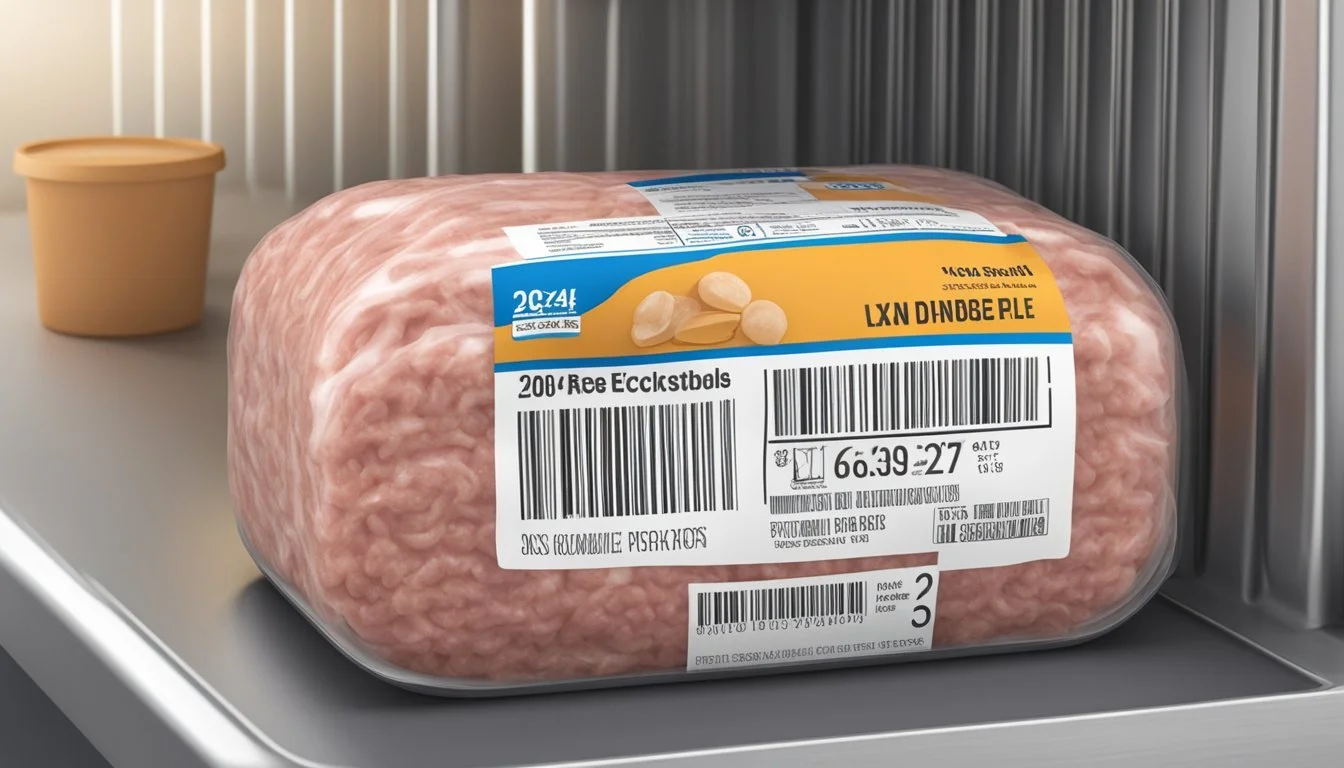How Long Does Ground Pork Last?
Shelf Life and Storage Tips
Ground pork is a versatile ingredient that can be used in numerous dishes, ranging from meatballs to stir-fries. Knowing how long ground pork lasts is essential for food safety and quality. In the refrigerator, raw ground pork maintains quality for up to 2 days when stored at or below 40°F. It is crucial to store it in an airtight container or wrapped securely to prevent cross-contamination and to ensure it stays within the correct temperature range.
In the freezer, ground pork exhibits best quality for about 3 to 4 months, although it remains safe to consume beyond this period if kept at a constant 0°F. Air-tight packaging is equally important in the freezer to prevent freezer burn and protect the meat's quality. Cooked ground pork, when refrigerated, can be safely consumed for up to 4 days. It should be cooled to room temperature before storing and should not be left out for more than 2 hours, or 1 hour if the ambient temperature is above 80°F, to prevent bacterial growth.
Ground Pork Basics
Ground pork is a versatile ingredient in the culinary world, known for its flavorful contribution to various recipes. It is derived from pork, which is minced or ground, and can vary greatly in taste and texture based on the cut and preparation.
What Is Ground Pork?
Ground pork is the product of pork meat that has been finely chopped or ground by a meat grinder. It usually comes from the shoulder of a pig, although it can be made from almost any part of the pig. The fat content can vary: some ground pork has a lean-to-fat ratio of 70:30, while other variants might be leaner or fattier. This ratio is critical for both flavor and the way ground pork cooks in recipes.
Different Uses of Ground Pork
Ground pork is prized for its role in an array of recipes and can be tailored to a wide variety of culinary applications. Here are common uses of ground pork:
Meatballs: When mixed with spices and seasoning, ground pork adds juiciness to meatballs.
Sausages: It serves as the primary ingredient in many types of sausage, contributing to the sausage's body and taste.
Stuffed vegetables: Ground pork often acts as a hearty filling for vegetables like bell peppers or zucchini.
Dumplings and egg rolls: It's a common filling, delivering a savory punch in many Asian dishes.
Pasta sauces: Ground pork can also enrich pasta sauces, providing a robust flavor.
With its various uses, ground pork is a staple ingredient in cuisines worldwide, bringing a rich flavor and texture to recipes ranging from Italian to Asian.
Storing Ground Pork
Proper storage of ground pork is crucial for maintaining its safety and quality. It involves refrigerating promptly and using appropriate containers or wraps to minimize exposure to air.
Refrigeration Techniques
Refrigeration is essential to slow down bacterial growth on ground pork. It should be stored in the fridge at a temperature below 40°F. For optimal freshness, one should place ground pork in an airtight container or wrap it tightly in plastic wrap to reduce air exposure. Ground pork should be used within 1 to 2 days when stored in the refrigerator.
Freezing and Thawing Methods
To extend the shelf life of ground pork, freezing is recommended. Ground pork can be stored in the freezer for 3 to 4 months. It must be kept at a constant temperature of 0°F for safe storage. Use freezer bags or wrap the pork tightly in aluminum foil before storing to prevent freezer burn. When defrosting, ground pork should be placed in the refrigerator to thaw slowly, maintaining a consistent temperature to prevent bacterial growth.
Identifying Freshness
When considering the freshness of ground pork, one must be attentive to its smell, texture, and color, as these are critical indicators of quality. Consumers should perform a thorough assessment to ensure the meat is safe and suitable for consumption.
Assessing Pork Quality
Smell: Fresh ground pork should have a very light, almost neutral odor. Any off smell or sour smell can indicate spoilage.
Texture: High-quality ground pork is typically firm to the touch. If the meat feels sticky or slimy, it should not be used.
Color: The appearance of fresh ground pork is usually a pinkish-red. Consistent coloring is a sign of good quality; one should be cautious of any grey or brown spots.
Signs of Spoilage
Odor: A sour or rancid smell is a potent indicator that ground pork has gone bad.
Visual Signs: A change to an uncharacteristic grey or brown color and the presence of slimy texture when touched suggest the meat is no longer fresh.
Touch: Similar to visual signs, if ground pork feels slimy or overly sticky, it has likely spoiled and should not be consumed.
Shelf Life Guidelines
The shelf life of ground pork is determined by how it's stored. Refrigeration and freezing can significantly impact its freshness and safety for consumption.
Refrigerated Ground Pork
Ground pork should be stored in the refrigerator at a temperature below 40°F. Its shelf life is typically 1 to 2 days after purchase. Ground pork should be placed in a sealed container or wrapped tightly to prevent contamination and preserve quality.
Sell-by date: Ground pork can still be safe to consume 1 to 2 days after the sell-by date if it has been continuously refrigerated.
Storage method: To extend freshness, store ground pork in the coldest part of the refrigerator.
Frozen Ground Pork
When frozen, ground pork's shelf life extends to approximately 3 to 4 months. Proper storage involves keeping the meat at 0°F or lower, which maintains its quality and prevents spoilage.
Freezer storage: Use airtight containers or freezer bags to protect ground pork from freezer burn.
Thawing: Once thawed in the refrigerator, ground pork should not be refrozen and ought to be used within 1 to 2 days.
Safety Measures
When handling ground pork, understanding and implementing the right safety measures is critical to preventing foodborne illnesses. One must prioritize appropriate storage temperatures and cooking techniques to maintain the health and safety of those consuming the pork.
Preventing Foodborne Illnesses
Ground pork, like all meats, is a potential breeding ground for bacteria if not handled correctly. It's imperative to store ground pork at a temperature below 40°F to slow bacterial growth. Storage guidelines suggest keeping ground pork in the fridge for no more than 1-2 days. If one needs to store ground pork for longer, freezing is advised, extending its shelf life to 2-3 months. When freezing, make sure to expel as much air as possible to avoid freezer burn and use airtight containers or freezer bags.
In terms of safety, any ground pork left out at room temperature for over 2 hours, or just 1 hour if the temperature is above 90°F, should be discarded to prevent the risk of food poisoning.
Proper Cooking Techniques
Cooking ground pork thoroughly is essential. It should be heated to an internal temperature of 145°F, which needs to be checked with a food thermometer. This temperature is critical to ensure the elimination of harmful bacteria that can cause illness. Moreover, after cooking, it's recommended to let the meat rest for at least three minutes before consumption. This resting period allows the temperature to continue to rise slightly, which can provide additional safety against bacteria like Salmonella and E. coli.
When to Discard Ground Pork
Determining when ground pork has gone bad is crucial to ensure food safety. Ground pork should be discarded if:
It has been stored raw in the fridge for more than 2 days.
It remains cooked in the fridge for over 4 days.
In the freezer, if it's been there for more than 4 months, the quality may decrease, although it remains safe to eat.
One should immediately throw out pork if any of these signs are noted:
Discoloration: If the meat shows signs of grayish coloring instead of a healthy pink.
Off-odor: Any sour or ammonia-like smell is a clear indicator of spoilage.
Tactile changes: A slimy or sticky texture after the meat has been thawed or refrigerated suggests bacterial growth.
Condition Action Required Raw in fridge > 2 days Discard Cooked in fridge > 4 days Discard Freezer > 4 months (quality issue) Best used within 4 months Discoloration Discard Unpleasant odor Discard Slimy texture Discard
It is important to monitor ground pork for spoilage to prevent foodborne illnesses caused by bacterial growth, such as those from Salmonella or E. coli. Always store ground pork at temperatures below 40°F and in airtight containers to mitigate the risks of bacteria growth.
Ground Pork After Cooking
Once ground pork is cooked, it has a limited shelf life and needs to be stored or consumed promptly. It's important for health and safety to handle leftovers correctly.
Storing Cooked Pork
Cooked ground pork should be stored in the refrigerator at or below 40°F within two hours of cooking. One can expect it to be safe for consumption for 3 to 4 days when stored properly. For longer preservation:
Place the cooked pork in airtight containers or heavy-duty freezer bags.
Alternatively, tightly wrap it with heavy-duty aluminum foil or freezer wrap.
If opting to freeze, cooked ground pork can be safely kept for 2 to 3 months.
Reheating and Leftovers
Reheating cooked ground pork properly is key to maintaining its quality and ensuring food safety. The pork should be heated to an internal temperature of 165°F to ensure that it is hot enough to kill any bacteria present. Here are guidelines for reheating:
Use a meat thermometer to check the internal temperature.
Reheat only as much as will be eaten to avoid multiple reheats.
For best quality, consume leftovers within the recommended fridge storage time of 3 to 4 days.
Remember to discard any cooked ground pork that has been left at room temperature for more than two hours, as it may have become unsafe to eat.
Common Questions Answered
When dealing with ground pork, two main concerns that frequently arise are the right way to handle freezer burn and the methods to defrost the meat quickly. Understanding these aspects ensures optimal quality and safety of the ground pork consumed.
Freezer Burn and Ground Pork
Freezer burn occurs when air reaches the meat's surface and causes dehydration and oxidation. Ground pork afflicted with freezer burn may develop grayish-brown dry spots and will not taste as good, although it remains safe to eat. To prevent freezer burn, one should:
Store ground pork in heavy-duty freezer bags, airtight containers, or wrap tightly with heavy-duty aluminum foil or freezer wrap.
Remove as much air as possible from the packaging before sealing.
One can still use freezer-burned ground pork in cooked dishes, but they should be aware that some flavor and texture qualities might be compromised.
Defrosting Ground Pork Quickly
To defrost ground pork quickly while maintaining safety standards, there are two primary methods that should be considered. One can either use a microwave or a cold water bath:
Microwave: Using the defrost setting or 30% power level, one can thaw ground pork quickly. The pork should be in a microwave-safe container and should be cooked immediately after thawing due to possible uneven heating.
Cold Water Bath: Submerge the sealed ground pork in cold water. Change the water every 30 minutes. One pound of ground pork may thaw within an hour, but larger amounts will take longer.
It is important never to defrost meat at room temperature or in hot water as it can cause the meat to enter the danger zone, between 40°F and 140°F, where bacteria multiply rapidly.
Comparing Ground Meats
When selecting ground meats, consumers often weigh factors such as shelf life, flavor, and versatility. Ground pork, beef, and chicken each have their own characteristics that suit different recipes and preparation methods.
Ground Pork Versus Other Meats
In comparison to other ground meats, ground pork has a distinctly rich flavor and tends to be juicier due to its higher fat content. It's the meat of choice for many sausages and is prized for the tender texture it imparts to meatballs and other dishes. Typically, raw ground pork has a fridge shelf life of 1 to 2 days when stored below 40°F.
Contrastingly, ground beef offers a robust taste and is commonly used for burger patties and meatloaf. It can usually remain in the fridge for 1 to 2 days as well and requires similar storage conditions to prevent spoilage.
Ground chicken, known for its leaner profile, is a healthier option that complements a wide variety of flavors, making it ideal for lighter meals. It has a slightly longer refrigerator shelf life of 1 to 2 days, which is akin to the storage time for ground turkey.
Each type of ground meat should be stored in an airtight container and kept away from the warmer parts of the refrigerator, like the door. To ensure safety and quality, one should not leave ground meats at room temperature on the counter for more than 2 hours, or 1 hour if the ambient temperature is above 80°F.
Choosing the Right Meat for Your Recipe
When deciding which ground meat to use, one must consider the desired outcome of the dish.
Ground pork is the perfect selection for recipes that benefit from a tender texture and a slightly sweet taste, such as meatballs or dumpling fillings.
Ground beef should be chosen for its bold flavor, making it the staple in hearty dishes like hamburgers or chili.
Ground chicken offers a canvas for a variety of senses to shine through, especially in recipes calling for delicate or nuanced seasonings.
The choice of meat can profoundly affect the final dish, influencing not only the taste but also the nutritional content. For those wishing to cut down on fat, ground chicken may be preferable, while for others seeking succulence and richness, ground pork or beef may be more appropriate.
Choosing the right ground meat also involves considering the freshness and color, both of which are indicators of quality. Ground meats should have a consistent texture and color, with no off-putting odors or sliminess, regardless of the variety.








